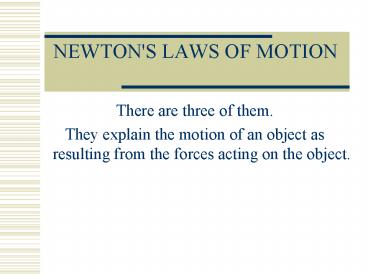NEWTON'S LAWS OF MOTION - PowerPoint PPT Presentation
Title:
NEWTON'S LAWS OF MOTION
Description:
Title: NEWTON'S LAWS OF MOTION Author: Physics Department Last modified by: Norman Herr Created Date: 1/13/1998 10:33:00 PM Document presentation format – PowerPoint PPT presentation
Number of Views:137
Avg rating:3.0/5.0
Title: NEWTON'S LAWS OF MOTION
1
NEWTON'S LAWS OF MOTION
- There are three of them.
- They explain the motion of an object as resulting
from the forces acting on the object.
2
What is a force?
- An interaction between TWO objects.
- For example, pushes and pulls are forces.
- We must be careful to think about a force as
acting on one object - from (or due to ) another object.
3
Adding Forces
- Forces are vectors (They have both magnitude and
direction) and so add as follows - In one dimension, note direction using a or
sign then add like scalar quantities (regular
numbers with no direction associated with them) - Examples
3 N
3 N
6 N
0 N
3 N
-3 N
4
Newtons First Law
- Consider a body on which no net force acts. If
the body is at rest, it will remain at rest. If
the body is moving with constant velocity, it
will continue to do so.
5
- Consider a body on which no net force acts
- An important word here is NET. It means total
or sum of all (forces). - It is not that no force at all can act on the
body. It is just that all the forces must add to
zero (cancel each other out).
6
- Under this condition (no net force acting on the
body) - If the body is at rest, it will remain at rest.
- If the body is moving with constant velocity, it
will continue to do so. - What if the body is moving with a velocity which
is not constant? Why isnt this discussed?
7
Newtons Second Law in One Dimension
- Commonly shortened to Fma. Correctly, it is
- Only forces which act on that object affect the
acceleration of the object. - Forces exert by the object on another object do
not.
8
Using Newtons 2nd Law to Solve Problems
- Identify all forces acting on the object
- -Pushes or Pulls -Frictional forces
-Tension in a string -Gravitational Force (or
weight mg where g is 9.8 m/s2)- Normal
forces (one object touching another). - Draw a Freebody Diagram-draw the object, show
all forces acting on that object as vectors
pointing in the correct direction. Show the
direction of the acceleration. - Chose a coordinate system.
- Translate the freebody diagram into an algebraic
expression based on Newtons second law.
9
Consider an elevator moving downward and speeding
up with an acceleration of 2 m/s2. The mass of
the elevator is 100 kg. Ignore air
resistance.What is the tension in the cable?
- Identify Forces Tension in cable, weight of the
elevator - Draw freebody diagram
- Chose coordinate system Let up be the y
direction and down y. Then - Translate the FBD into an algebraic expression.
T-W m(-a) so - T-(100 kg)(9.8 m/s2) (100 kg)(-2 m/s2)
v
Note No negative sign
10
Newtons Third Law
- Whenever one object (object A) exerts a force on
another object (object B), the second object
exerts a force back on the first object. - These forces are ALWAYS equal in magnitude (but
they point in opposite directions). - Such forces are called Newtons third law force
pairs. - Not all forces that are equal and opposite are
third law force pairs. - The forces are on different bodies, so do not add
to zero.































